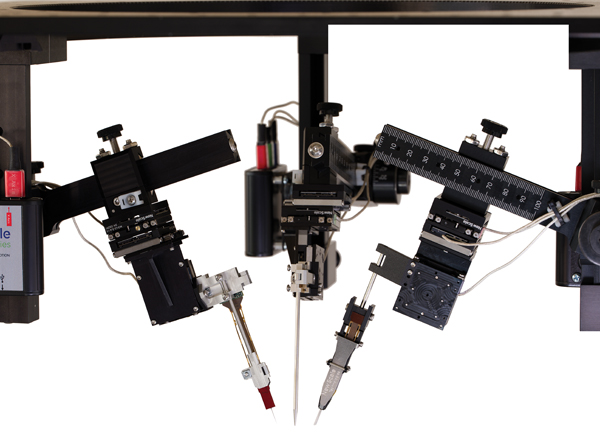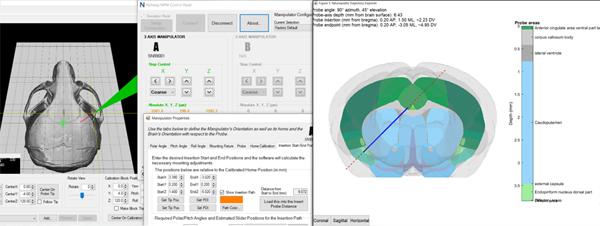Multi-Probe Micromanipulator System
Multiple silicon probes. One simple micromanipulator system.
Maximize productivity and precision with automated probe positioning for acute in-vivo recording
Supports neural probes from imec Neuropixels, NeuroNexus, Cambridge Neurotech and more
The MPM Multi-Probe Micromanipulator System provides automated positioning and insertion of multiple neural probes for acute in-vivo recording in electrophysiology and optogenetic research. Simple to set up and operate, it is the first micro-manipulator designed specifically for use with silicon neural probes.
The compact hardware design enables independent positioning – and simultaneous insertion – of multiple probes in the smallest space, with ample clear area for a virtual task environment.
Pathfinder Software with virtual coordinate system (VCS) enables simulation, planning and execution of experiments. All probes move in a common stereotactic coordinate space. Visualize real-time probe locations and monitor brain activity during insertion, through integration with open-source trajectory planning and data acquisition apps.
Compact, easy-to-use system
Multiple probes in the smallest space
A mounting ring allows multiple probe arm assemblies to be positioned around the target – from one probe to eight or more. Plan trajectories, independently move each probe to its starting position, and then simultaneously insert all probes, automatically.
Simple manual pre-adjustment
Each probe arm has four degrees of freedom for initial pre-adjustment. Use the displacement markings to register the location of each probe in stereotactic coordinates and calculate the approach angle. Enter this information into the Pathfinder Software Virtual Coordinate System (VCS) and use simulation mode to confirm probe trajectories. Remove real-time geometry puzzles from the time it takes to do a recording.
Precise motorized positioning
Each probe arm has three axes of motorized motion for precise control of x-y location and insertion depth, Each motorized stage has 15 mm of travel, with high force and stiffness. These stages, and an exceedingly stable mechanical loop from probe tip to manipulator, ensure a drift-free manipulator environment.
Use the MPM System to independently position and automatically insert multiple high-density silicon probes, for acute in-vivo neural recording.
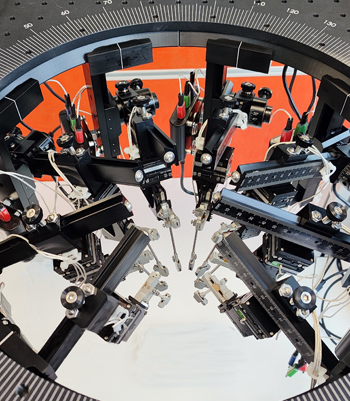
PATHFINDER SOFTWARE – Planning, simulation, execution

MPM Pathfinder Software with Virtual Coordinate System (VCS) simplifies planning, simulation and execution. Use it with open-source trajectory planning apps (Neuropixels Trajectory Explorer, Pinpoint) to plan insertion paths: Pathfinder calculates all angles for fast hardware setup to achieve the trajectory. Spend less time calculating angles, more time recording.
Use Pathfinder’s simulation mode to plan and visualize probe positions and approach angles, check for interference, and practice insertions.
During insertion, pass probe coordinates to trajectory planning apps and visualize real-time probe locations in a 3D brain model. Use data acquisition apps (Open Ephys GUI, SpikeGLX, Allego) to display real-time brain region activity and channel depth during insertion.
- Control multiple probes in stereotactic coordinates with simplicity and reproducibility
- Use trajectory planning and data acquisition apps to support both planning and insertion
- Use simulation mode for fast setup and training
- Control up to eight probes in a single PC window (open additional windows for more probes)
-
Position multiple probes independently – insert multiple probes simultaneously
- Automate insertion with very slow, programmable speed and x/y movement disabled
- Optional joystick, gaming controller or other input device control (PC compatible USB-HID)
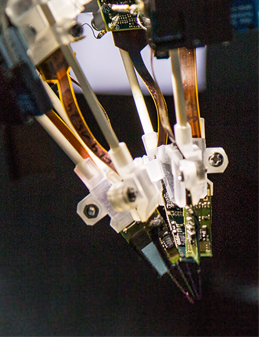
Image courtesy Allen Institute
“[VCS] takes the hassle out of multi-probe alignment… makes it much easier to keep track of probe locations when many are in use simultaneously.”
– Josh Siegle, The Allen Institute for Brain Science
Designed for High-Density Silicon Neural Probes
Neuropixels – NeuroNexus – Cambridge Neurotech
The MPM System is the first micromanipulator specifically designed for silicon neural probes. Probe mounting kits are available for Neuropixels probes; along with NeuroNexus, Cambridge and more. We also offer custom probe mount design services – contact us with your requirements.
NEW (August 2023): Neuropixels announced availability of its Neuropixels 2.0 multi-shank 10mm probes; see Neuropixels.org. MPM System users should order Neuropixels 2.0 probes with metal dovetail cap. A probe mount for the MPM System is in development. Contact us to pre-order a probe mounting kit.
The MPM System can be used to simultaneously position optical waveguides or optical fibers, for research combining electrophysiology with optogenetic stimulation.
Protect your probes
Our probe mounts, probe mounting kits, and alignment fixtures make it easier to attach delicate silicon probes to the manipulators. A steel reference probe reduces setup time and minimizes risk of damage to probes during setup. Once you have determined your probe angles and insertion paths using the reference probe and Pathfinder Software, repeatable stops on the probe arms allow you to simply swing the arm up to replace the reference probe with a silicon probe, and return it to the target position.
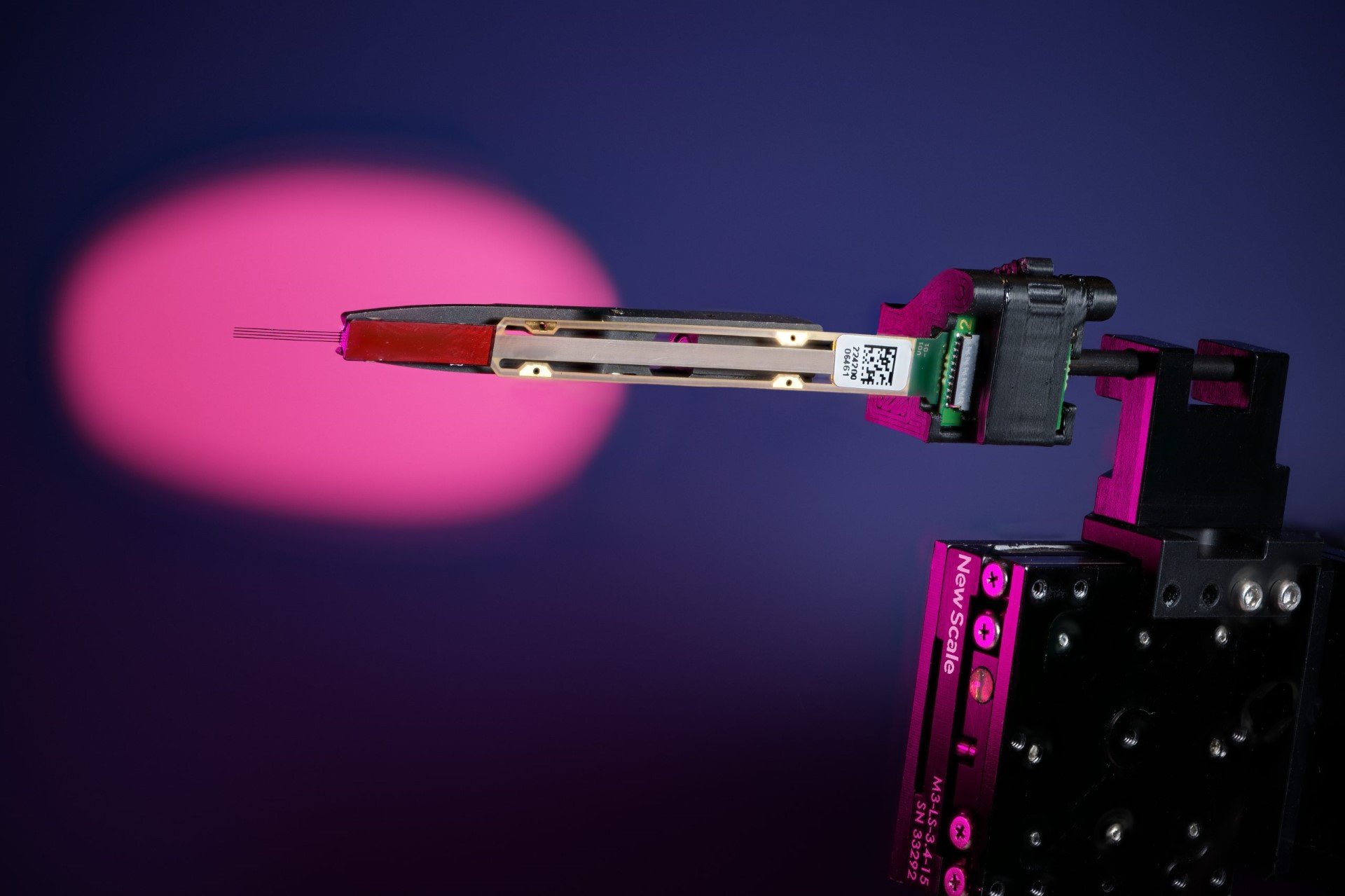
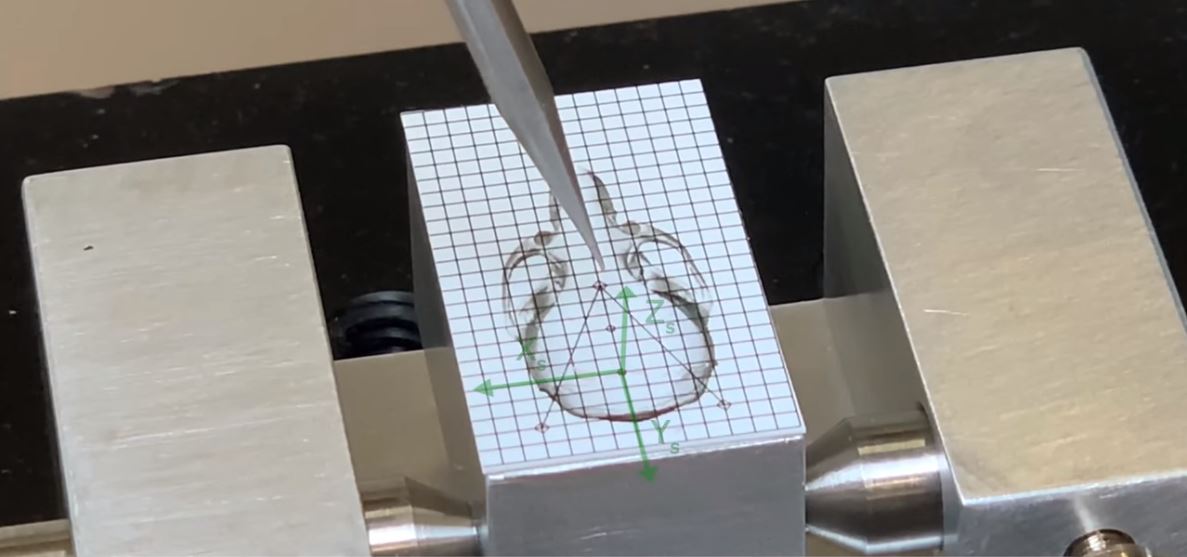
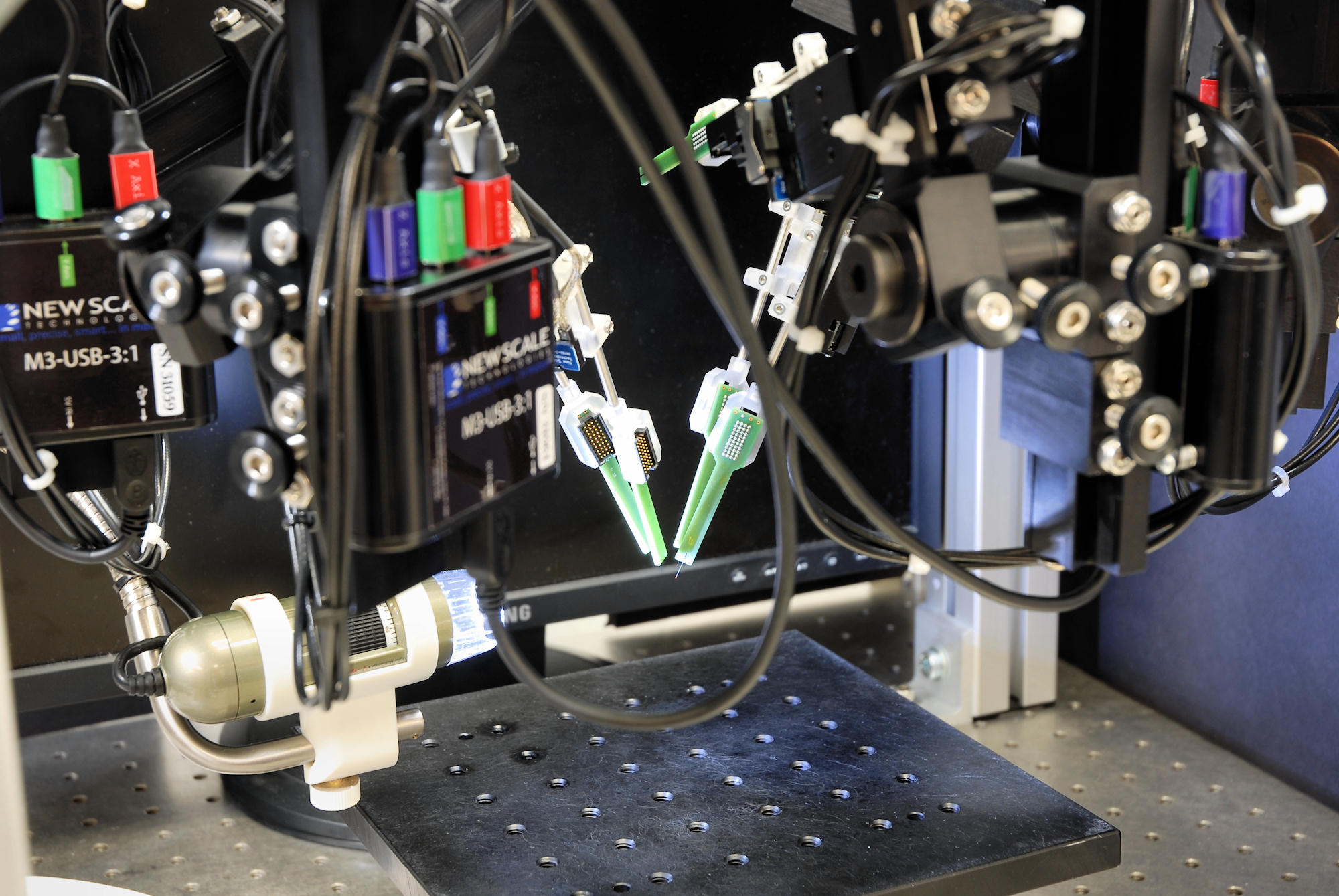
“Using the VCS system… saved a lot of time during experiments. I was really happy with the accuracy and reproducibility.”
-Tobi Leva, MDC-Berlin
MPM System Advantages
- Compact size: Position multiple probes in the smallest space
- Fast set-up: Fully engineered, modular apparatus for upright or inverted experiments
- Simulation, planning and execution with Pathfinder Software
- 3D visualization for planning probe positions and approach angles
- Integration with open-source tools for trajectory planning and data acquisition
- Precise execution of probe insertions based on the simulation
- Real-time feedback of probe positions during insertion, through data acquisition tools
- Automated sub-micrometer probe movement with absolute position measurement and control
- Gross manual pre-positioning and fine automated control in one system
- Four-axis manual adjustment of probe arms, with repeatable stops
- Three-axis motorized fine positioning, with 15 mm travel on each axis
- Exceedingly stable mechanical loop from probe tip to manipulator, for drift-free operation
Configurable to your experiment
MPM Systems are fully configurable for inverted or upright position, number of probe arms, and type of probe holders.
In the inverted configuration, the arms are mounted to the underside of an elevated platform, maximizing clear space below the probes for animal interaction with a virtual task environment. In the upright configuration, the arms are mounted to a standard laboratory table.
Each system is complete and easy to assemble with the tools and hardware provided. All cables and connectors are labeled, including standard USB cables to the PC. The MPM software installs on your Windows PC in minutes.
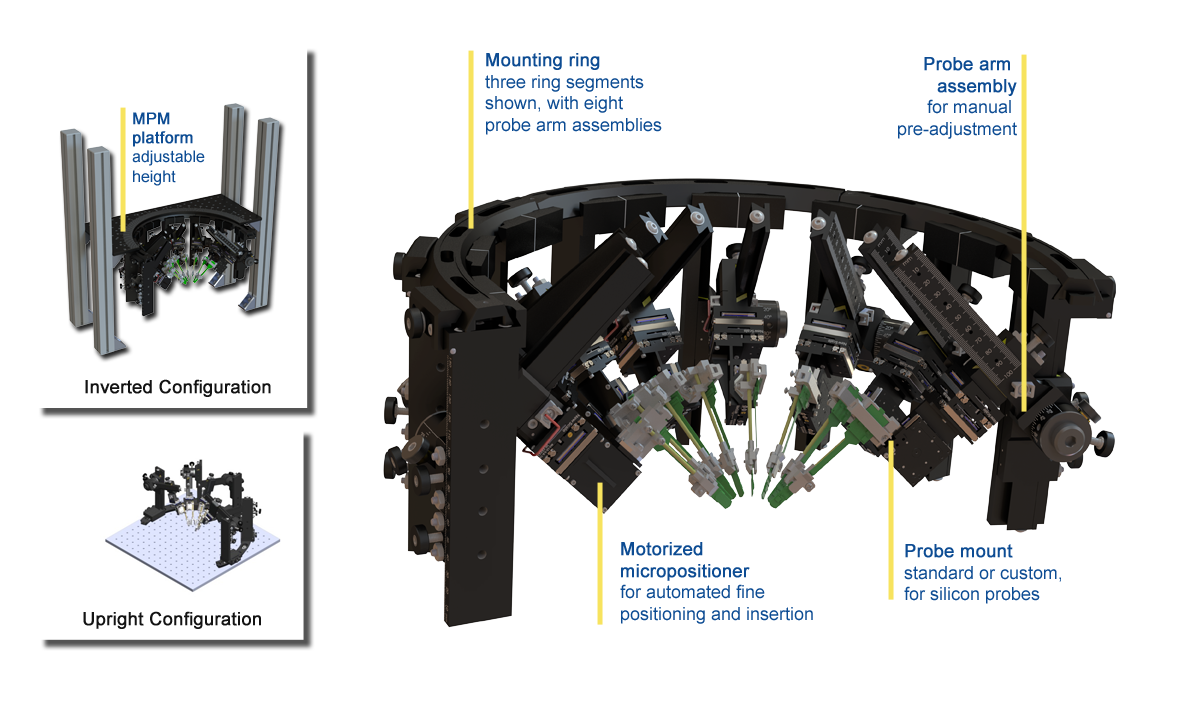
Neuroscience Blog
Live Demo: 4-Shank Probe Trajectory Planning | Pathfinder, Pinpoint & NTE
See how to plan trajectories and insert multiple 4-shank silicon probes, viewing real-time positions in the Allen CCF with Pinpoint & NTE. About this presentation: The latest releases of...
Upright Magnetic Arms, with Extender Posts, Improves 4DOF Multi-Probe Micromanipulator Flexibility
By Ed Friedrich Many of our Multi-Probe Micromanipulator users look to us for guidance on how to optimize their Multi-Probe Micromanipulator (MPM) configuration for their lab and research goals. Our answer is usually “it depends” – what does the behavioral apparatus...
Improvements to the Multi-Probe Micromanipulator System
By Ed Friedrich We love hearing from our customers, and we truly listen to constructive feedback and opportunities for improvement. Over the past year, we have been thrilled with the progress MPM users have made with our ambitious Pathfinder Software initiative,...
USER PORTAL
Download software and user guides for your MPM System. Watch How-To videos on system setup and operation. (User account creation required)
Drawings
Download drawings and hardware guides to plan your purchase and installation of an MPM System. (Register here if you don’t have a user account)
Where To Buy
Sales and support for the MPM System is provided by worldwide partners with experience in neuroscience and advanced research instrumentation.

